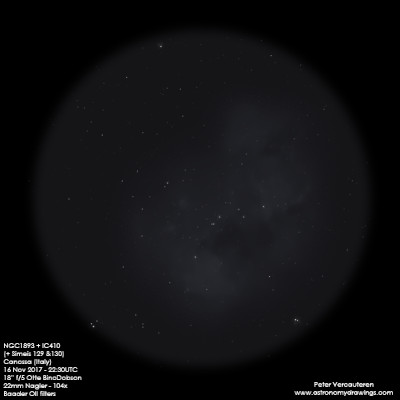
Max Wolf discovered IC 410 on 25 Sep 1892 on a Heidelberg plate. In AN 3130, p159, he noted the plate revealed a group of stars and a large nebula surrounding the star BD +33°1023. His position matches the brightest star (mag 9.0 HD 242908) in the nebula. NGC 1893 refers only to the open cluster, which was discovered by John Herschel.
300/350mm - 13.1" (1/18/85): very faint nebulosity involved with open cluster NGC 1893. The brightest portion is at the NW edge of cluster. A dark "hole" is just south of this nebulosity. More extensive nebulosity is suspected but difficult to confirm due to the general background haze of the cluster. Enhanced with UHC and OIII filters.
13.1" (2/25/84): nebulosity is evident preceding the NW star of the triangle of stars surrounding the cluster. Very faint but definite with a filter in poor transparency.
600/800mm - 24" (1/4/14): at 125x unfiltered; emission nebulosity was evident surrounding and beyond the borders of open cluster NGC 1893, but only a large patch to the northwest of the cluster stood out well. A UHC filter transformed the nebula to a showpiece and it appeared bright, very large (~30' diameter), very irregular with a large darker patch to the west of the central portion of the cluster. The brightest section of nebulosity was to the NW of the cluster (as noticed without a filter), though mag 9.0 HD 242908 (a hot 04-type star) at the NW tip of the cluster is at the east edge of this bright, 6' circular patch. Somewhat fainter nebulosity enveloped the entire cluster but an extensive field of nebulosity continued south of the cluster for an additional 10'. It was difficult to see a clean edge on the south and west side as the nebulosity seemed to gradually fade away, but the entire diameter was at least 25'.
The cometary "Tadpoles" nebulae Simeis 130 and 129, which contain recently minted stars, lie on the east end of the cluster. The "head" of Simeis 130 was immediately picked up at 200x as a very small, fairly high surface brightness knot with at least one star involved. At 260x and 375, two very close "stars" oriented WSW-ENE were embedded in the glow, with the ENE object quasi-stellar (would not focus to a sharp point) and perhaps a very tight pair. Although impressive on images, there was no sign of the wavy tail extending from the "head" towards the NE. Mag 9.1 BD+33 1028, 3' E of Simeis 130, along with a 6' group of a half-dozen mag 10-11 stars, were visually detached to the NE of the main cluster.
Notes by Steve Gottlieb